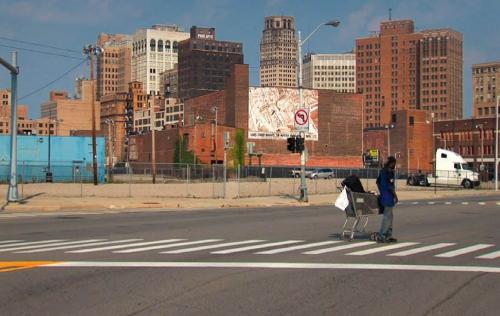-
Florent Tillon: Detroit: Wild City (2011)
Florent Tillon: Detroit: Wild City (2011)

STILL FROM DETROIT: WILD CITY
A Frenchman's images of America's most devastated city
Obviously as the former center of the thriving American automobile industry earlier in the 20th century, Detroit, Michigan was once the most industrialized city in the United States, a symbol both of organized labor and of the wealth of great factory overlords. It also had racial and economic problems right from the beginning. And its reliance on a single industry sowed the seeds of its downfall in recent decades as America has outsourced labor and become increasingly post-industrial. The city's once-grand train station was closed long ago, along with its art-deco dance halls, and its residential neighborhoods fell into decline. Now, Detroit is the most dramatically devastated of all American cities. About half its population has fled. The automobile industry is largely dormant. Asphalt gives way to grass.
In French filmmaker Florent Tillon's neutral, quietly observant documentary about the present physical, financial, and psychic state of Detroit, the city appears clearly on the edge, either of rebirth or annihilation. He uses archival footage to hint at the city's former prosperity; his own camera explores the emptiness and decay and he interviews a few articulate observers who like to explore the ruins and remember what they once were. Some people take delight in the way the near-abandoned city's vast number of empty and decaying vacant lots, factory buildings, and residential neighborhoods stand as a model for a post-apocalyptic world. Others drive in and out of town on the freeway, going to work in the fortress-like Renaissance Center (built unsuccessfully to revitalize the city in the Eighties) and having no other contact with Detroit itself. Still others work in urban farms raising herbs and vegetables and dream of the return to a viable agrarian subsistence life. In the "wild city" Detroit, there are chickens and goats. How this will revitalize the whole town remains unclear. It's also not exactly clear how the work of "Blight Busters," whose young volunteer crews rush around the city demolishing derelict buildings at some risk to their own health, will lead to urban renewal.
The city garden projects reflect a hope that in the largely empty shell of the once-proud and vibrant Motor City ("Motown") there can be basic urban renewal. These urban pioneers are recreating life among the ruins. But this is only one narrative of the city. For the majority poor, black, and unemployed of Detroit, the present situation is hardly a hopeful one. On the other hand, there are people who see the rock bottom status of Detroit as fertile ground for new capitalist enterprise. The latter, however, Tillon eschewed as not reflecting the "poetic" view of the city he wanted to convey.
Detroit: Wild City neither analyzes nor intrudes, though it certainly edits out. Statistics are not presented, nor is the role of government, either local or national, taken into account. Whether the film is a portrait of disaster or rebirth ultimately remains ambiguous. The film is at its best when the camera merely surveys buildings and freeways, or follows individuals who like to explore the devastated factories or the long abandoned train station. For Tillon Detroit is not a plan or a statistic. It's a poetic landscape that may represent the future of capitalism, or the outcome of all human endeavor in the great scheme of things: dust to dust, back to the earth, as new insects and birds move in to occupy a changed eco-system. Though only partly shown here, Detroit now (according to the film's blurb) contains "vast urban prairies, populated with a diverse array of wildlife including falcon, deer, and coyote," which "have replaced what once had been working- and middle-class neighborhoods."
Tillon is a keen observer with a fine and poetic eye. But while Tillon's documentary focuses on the city as an entity by itself, his approach is obviously highly selective, and somewhat arbitrary. He might have presented a more thorough account of his urban story, but he chose not to do so. It's an interesting fact, but not one given here, that nine of Forbes' list of the 400 richest Americans live in Michigan; but none of them is named Ford. As a visual meditation this Parisian's visit to the ruins of Motor City may inspire conclusions and even action, but there is no attempt to place Detroit in the larger context of American cities, some of which, like Baltimore, for instance, suffered similar declines for similar reasons but have been brought back to life. The ruins of a city are still a city. It can hardly turn into something else. What are the chances that Detroit can be restored -- and how? At least without more detail and more energetic coverage and interviewing, Tillon's picture of the agrarian back-to-nature movement in Detroit offers only the most wan of hopes. The rest seems a romanticizing and aestheticizing of poverty.
Seen and reviewed as part of the San Francisco International Film Festival 2011.
See also the 2012 Detroit documentary Detropia.
SFIFF Screenings
Fri, Apr 29 7:00 / Kabuki
Sun, May 1 2:45 / New People
Wed, May 4 8:40 / PFA
Last edited by Chris Knipp; 08-13-2017 at 10:10 PM.
 Posting Permissions
Posting Permissions
- You may not post new threads
- You may not post replies
- You may not post attachments
- You may not edit your posts
-
Forum Rules





 Reply With Quote
Reply With Quote
Bookmarks